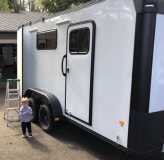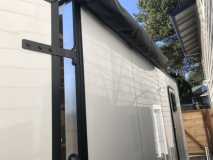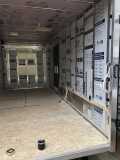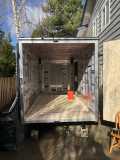



Slowly making some headway on the build, although this Portland Spring weather is making it difficult to do much of anything. Even bringing materials from the garage to the trailer without them getting soaked is challenging. Since the trailer's framing is 1x1.5 aluminum tube, the layers of insulation will be as follows. I know there is a lot of discussion on the pros and cons of insulation, but the goal is to try to avoid having to put in air conditioning (less about retaining heat in winter) and control moisture, and just using the Maxxair fan to be installed.
Walls: 1" Polyiso between wall studs, horizontal 1/2 OSB furring strips, with 1/2 Polyiso between, then the final wall which is 1/4" Baltic Birch (R-value will range between ~1 - 10 in spots)
Floor: Inside, 1" Polyiso on top of OE plywood floor, covered with sheets of 1/2 OSB, screwed down (R-value ~7)
Ceiling: 1.5" Foamular XPS, horizontal 1/2 OSB furring strips with 1/2 Polyiso in between, covered by another layer of length-wise furring strips and polyiso, then some cedar 4" T&G (R-value range between ~4 - 14 in spots)
Ordered the windows which are double pane acrylic from Tern Overland, there will be one large on passenger side, one small on drivers side, and two in front for bunks (one of the reasons we went with acrylic). Going to frame them in with 1x1 aluminum tube, 90 deg brackets, and rivets (after reading Alaska Teardrop's Northern Lite Traveler build 100 times).
Awning will be going in next weather permitting, so I can finish up the ceiling. I'm a little concerned about the weight of it, as it will be 70 lbs on the drivers side from the back corner to about halfway down the length of the trailer. It is the OVS 270 deg awning to cover the RV door and the galley in the back, overall pretty impressed with the build quality and the brackets should work out nicely. There are three brackets that come with two ubolts each to go under the ceiling studs (actually meant for roof racks I'm told). I am going to try to put 1/2 flat stock aluminum to try to spread the weight out amongst all the studs that is spans. Then wiring in awning lights and backup camera.
Lastly, when I picked up the trailer, I was frustrated to see my tailgate would hit the jack, so I picked up a Jack-E-Up adapter. Overall looks like a neat design, but I'll report back on if it actually works as advertised once installed.



